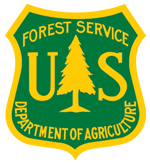Landscape Partnership Resources Library
Update to National Park Service
PDF version of Jean's presentation giving an update of the Appalachian LCC to the National Park Service.
Golden-winged Warbler Habitat: Best Management Practices
The goal of this BMP is to present management prescriptions to forest managers interested in providing breeding habitat for Golden-winged Warblers through management actions associated with timber harvesting. We provide a science-based approach in an adaptive management framework to understanding breeding habitat use of Golden-winged Warblers across a range of timber harvest prescriptions in Pennsylvania and Maryland. This document is intended for use by state and private foresters, biologists, and other land managers. We anticipate that this BMP is the first document in a series that will address management of other early successional habitat used by Golden-winged Warblers including old fields, reclaimed strip mines, scrub oak barrens, and aspen cuts.
Abstract and Progress Report for Q3 2012
Abstract and progress report from the Vendor for the Ecological Flows Project.
Appalachian LCC Reachback to Field Offices
A PowerPoint summary of the mission, governance structure, decision-support tools, and conservation priorities of the Appalachian LCC.
Stream channel geomorphology influences mussel abundance in southern Appalachian streams, U.S.A.
We quantified freshwater mussel abundance and species richness and their physical habitat at 24 sites in eight streams in southern Appalachian catchments in 2000 and 2001. In addition, we modelled site-specific hydraulic parameters during summer baseflow and bankfull stages to estimate high- and low-discharge conditions, respectively. Mussel abundance was related to stream geomorphology, whereas richness was related to stream size. Baseflow habitat parameters explained only minor variation in abundance or richness, and both measures were highly correlated with mean current velocity or stream size. Bankfull shear stress composed a relatively low proportion of overall mussel habitat variability, but it accounted for significant variation in abundance and richness. Mussel abundance was highly variable at sites subject to low-shear stress during spates, whereas abundance always was low at sites subject to high-shear stress. These data suggest that habitat conditions during floods, rather than those at summer baseflow, limit the abundance of mussels in Appalachian streams. These data also suggest that mussel abundance and assemblage structure may be sensitive to any changes in channel geomorphology and hydraulic conditions that might result from land use in the catchment.
Stakeholder participation for environmental management: A literature review
The complex and dynamic nature of environmental problems requires flexible and trans- parent decision-making that embraces a diversity of knowledges and values. For this rea- son, stakeholder participation in environmental decision-making has been increasingly sought and embedded into national and international policy. Although many benefits have been claimed for participation, disillusionment has grown amongst practitioners and stakeholders who have felt let down when these claims are not realised. This review first traces the development of participatory approaches in different disciplinary and geograph- ical contexts, and reviews typologies that can be used to categorise and select participatory methods. It then reviews evidence for normative and pragmatic benefits of participation, and evaluates limitations and drawbacks. Although few of the claims that are made have been tested, there is evidence that stakeholder participation can enhance the quality of environmental decisions by considering more comprehensive information inputs.
Pragmatic population viability targets in a rapidly changing world
To ensure both long-term persistence and evolutionary potential, the required number of individuals in a population often greatly exceeds the targets proposed by conservation management. We critically review minimum population size requirements for species based on empirical and theoretical estimates made over the past few decades. This literature collectively shows that thousands (not hundreds) of individuals are required for a population to have an acceptable probability of riding-out environmental fluctuation and catastrophic events, and ensuring the continuation of evolutionary processes. The evidence is clear, yet conservation policy does not appear to reflect these findings, with pragmatic concerns on feasibility over-riding biological risk assessment. As such, we argue that conservation biology faces a dilemma akin to those working on the physical basis of climate change, where scientific recommendations on carbon emission reductions are compromised by policy makers. There is no obvious resolution other than a more explicit acceptance of the trade-offs implied when population viability requirements are ignored. We rec- ommend that conservation planners include demographic and genetic thresholds in their assessments, and recognise implicit triage where these are not met.
RFA Conference Call Q & A - March 9, 2011
Approximately 25 individuals participated on the first informational call for the Appalachian Landscape Conservation Cooperative (LCC), held at 10AM on March 9, 2012. The following agencies/organizations were represented (this may not be a complete list): NatureServe, University of Georgia, Ohio State, West Virginia University, USGS (multiple locations), National Wildlife Foundation, University of Connecticut, University of Missouri, University of Kentucky, Equinox Environmental, NC State, Interstate Commission on the Potomac River Basin, SUNY Environmental Science and Forestry.
Bill Uihlein PPT presentation pdf
Bill Uihlein's Role of Landscape Conservation Cooperatives in Sustaining Natural and Cultural Resources presentation
Science Seminar Series - Patch Metrics, Wild Brook Trout, and the Chesapeake Bay
The wild brook trout resource in the Chesapeake Bay has been significantly reduced over the last 150 years and faces ongoing and future threats from climate change, land use changes, invasive species and loss of genetic integrity (Hudy et al. 2008). Monitoring both short and long term trends on individual brook trout (Salvelinus fontinalis) populations and the resource as a whole are important needs of managers. Past assessments on the 1,443 subwatersheds in the Chesapeake Bay found that 226 had healthy brook trout (intact); 542 had reduced populations and 290 were extirpated (Hudy et al. 2008). However, the subwatershed scale assessment was not fine scale enough to efficiently monitor trends on the ground of interest to many mangers. Standard population estimates using mark-recapture and depletion removal estimates are also not viable for large scale monitoring because of expense, inability to detect trend (i.e. large coefficient in variation), and problems expanding the sample to the entire population. However, fine scale occupancy data (at the catchment level) exist for the majority of the brook trout resource in the Chesapeake Bay. Currently (not counting New York, not completed yet), there are 3,003 catchments containing allopatric brook trout populations; 1,716 catchments containing sympatric populations (with brown or rainbow trout); and 1,966 catchments containing only exotic trout species. We used this fine scale catchment data to identify unique patches of brook trout. We define a "patch" as a group of contiguous catchments occupied by wild brook trout. Patches are not connected physically (separated by a dam, unoccupied warm water habitat, downstream invasive species, etc) and are generally assumed to be genetically isolated. In the Chesapeake Bay there are 868 patches of brook trout habitat with an average patch size of 2,800 ha.
Rising to the Urgent Challenge Strategic Plan for Responding to Accelerating Climate Change
The U.S. Fish and Wildlife Service climate change strategy, titled “Rising to the Urgent Challenge: Strategic Plan for Responding to Accelerating Climate Change,” establishes a basic framework within which the Service will work as part of the larger conservation community to help ensure the sustainability of fish, wildlife, plants and habitats in the face of accelerating climate change. The plan is implemented through a dynamic action plan that details specific steps the Service will take during the next five years to implement the Strategic Plan.
A System for Assessing Vulnerability of Species (SAVS) to Climate Change pdf
Sustained conservation of species requires integration of future climate change effects, but few tools exist to assist managers. The System for Assessing Vulnerability of Species (SAVS) identifies the relative vulnerability or resilience of vertebrate species to climate change.
Building partnerships and establishing consensus on regional priorities across the Upper Midwest and Great Lakes Landscape Cooperative - Final Report
As part of our project to identify the most climate vulnerable species in the Upper Midwest and Great Lakes Landscape Conservation Cooperative we have completed phase one of our project. This report summarizes our findings to date.We completed ten workshops across the region and have compiled a regional list of priority wildlife species for consideration in a climate vulnerability assessment. Included in the report are the top 30 species shared as priorities across the region, as well as the individual lists from each workshop.
Restoration of Ailing Wetlands
It is widely held that humankind’s destructive tendencies when exploiting natural resources leads to irreparable harm to the environment. Yet, this thinking runs counter to evidence that many ecological systems damaged by severe natural environmental disturbances (e.g., hurricanes) can restore themselves via processes of natural recovery. The emerging field of restoration ecology is capitalizing on the natural restorative tendencies of ecological systems to build a science of repairing the harm inflicted by humans on natural environment. Evidence for this, for example, comes from a new metaanalysis of 124 studies that synthesizes recovery of impacted wetlands worldwide. While it may take up to two human generations to see full recovery, there is promise, given human will, to restore many damaged wetlands worldwide
Structural and Functional Loss in Restored Wetland Ecosystems
Wetlands, which include tropical mangroves and boreal peatlands, are among the most valuable ecosystems in the world because they provide critical ecosystem goods and services, such as carbon storage, biodiversity conservation, fish production, water purification, and erosion control. As global change accelerates the loss of wetlands, attempts are increasing to restore this fragile habitat and its associated functioning. There has been no global evaluation, however, of how effective such restoration efforts have been. Here, we present a meta-analysis of the biological structure (driven mostly by plant communities) and biogeochemical functioning (driven primarily by the storage of carbon in wetland soils) of 621 wetland sites.
Responding to Climate Change on National Forests: A Guidebook for Developing Adaptation Options
From the USDA Forest Service, comes a recently published guidebook for climate change adaptation in national forests. It provides a state-of-science summary of principles of adaptation, methods for vulnerability assessment, and tools and processes to facilitate the development of adaptation strategies and tactics. Distributed to all 176 national forest units, the guidebook is being used throughout the Forest Service and by other agencies to integrate climate change in sustainable resource management.
RFA Conference Call Q & A - March 19, 2011
There were approximately 12 participants on this second informational call. Many had participated in our first call, but new entities included: Downstream Strategies, Ecological Modeling, U. of VA., Penn. State, and Environmental Services.


























